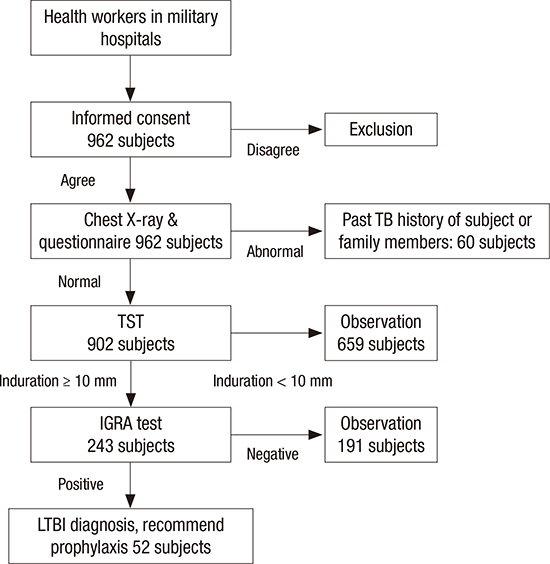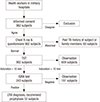1. World Health Organization. Global Tuberculosis Report 2016. Geneva: World Health Organizaition;2016.
2. Korea Centers for Disease Control and Prevention. 2017 National Tuberculosis Control Guideline. Cheongju: Korea Centers for Disease Control and Prevention;2017.
3. Statistics Korea. Causes of Death Statistics in 2015. Daejeon: Statistics Korea;2016.
4. Korea Centers for Disease Control and Prevention. 2013 National Tuberculosis Control. Cheongwon: Korea Centers for Disease Control and Prevention;2013.
5. World Health Organization. WHO Policy on TB Infection Control in Health-care Facilities, Congregate Settings and Households. Geneva: World Health Organization;2009.
6. Jensen PA, Lambert LA, Iademarco MF, Ridzon R. CDC. Guidelines for preventing the transmission of Mycobacterium tuberculosis in health-care settings, 2005. MMWR Recomm Rep. 2005; 54:1–141.
7. Moon HW, Kim H, Hur M, Yun YM, Lee A. Latent tuberculosis infection screening for laboratory personnel using interferon-γ release assay and tuberculin skin test in Korea: an intermediate incidence setting. J Clin Lab Anal. 2011; 25:382–388.
8. Jo KW, Woo JH, Hong Y, Choi CM, Oh YM, Lee SD, Kim WS, Kim DS, Kim WD, Shim TS. Incidence of tuberculosis among health care workers at a private university hospital in South Korea. Int J Tuberc Lung Dis. 2008; 12:436–440.
9. Park HY, Jeon K, Suh GY, Kwon OJ, Chung DR, Yoonchang SW, Kang ES, Koh WJ. Interferon-γ release assay for tuberculosis screening of healthcare workers at a Korean tertiary hospital. Scand J Infect Dis. 2010; 42:943–945.
10. Kim SY, Park MS, Kim YS, Kim SK, Chang J, Kang YA. Conversion rates of an interferon-γ release assay and the tuberculin skin test in the serial monitoring of healthcare workers. Infection. 2013; 41:511–516.
11. Kang CI, Choi CM, Kim DH, Kim CH, Lee DJ, Kim HB, Kim NJ, Oh MD, Choe KW. Pulmonary tuberculosis in young Korean soldiers: incidence, drug resistance and treatment outcomes. Int J Tuberc Lung Dis. 2006; 10:970–974.
12. Korea Centers for Disease Control and Prevention. Annual Report on the Notified Tuberculosis Patients in Korea 2009. Seoul: Korea Centers for Disease Control and Prevention;2010.
13. Ministry of National Defense. Military Healthcare Act. Seoul: Ministry of National Defense;2015.
14. World Health Organization. Guidelines on the Management of Latent Tuberculosis Infection. Geneva: World Health Organization;2015.
15. Korea Centers for Disease Control and Prevention. Health Facility Tuberculosis Control Guideline. Cheongju: Korea Centers for Disease Control and Prevention;2016.
16. Joint Committee for the Revision of Korean Guidelines for Tuberculosis. Korea Centers for Disease Control and Prevention. Korean Guidelines for Tuberculosis. 2nd ed. Cheongju: Korea Centers for Disease Control and Prevention;2014.
17. Joung SM, Ryoo S. BCG vaccine in Korea. Clin Exp Vaccine Res. 2013; 2:83–91.
18. Mazurek GH, Jereb J, Vernon A, LoBue P, Goldberg S, Castro K; IGRA Expert Committee; Centers for Disease Control and Prevention (CDC). Updated guidelines for using interferon gamma release assays to detect Mycobacterium tuberculosis infection - United States, 2010. MMWR Recomm Rep. 2010; 59:1–25.
19. Korea Centers for Disease Control and Prevention. Guidelines for Tuberculosis Control in Health Facility 2016. Cheongju: Korea Centers for Disease Control and Prevention;2016.
20. Menzies D, Fanning A, Yuan L, Fitzgerald M. Tuberculosis among health care workers. N Engl J Med. 1995; 332:92–98.
21. Baussano I, Nunn P, Williams B, Pivetta E, Bugiani M, Scano F. Tuberculosis among health care workers. Emerg Infect Dis. 2011; 17:488–494.
22. Chung YK, Ahn YS, Jeong JS. Occupational infection in Korea. J Korean Med Sci. 2010; 25:S53–S61.
23. Lee K, Han MK, Choi HR, Choi CM, Oh YM, Lee SD, Kim WS, Kim DS, Woo JH, Shim TS. Annual incidence of latent tuberculosis infection among newly employed nurses at a tertiary care university hospital. Infect Control Hosp Epidemiol. 2009; 30:1218–1222.
24. Herrera V, Perry S, Parsonnet J, Banaei N. Clinical application and limitations of interferon-gamma release assays for the diagnosis of latent tuberculosis infection. Clin Infect Dis. 2011; 52:1031–1037.
25. Lee JK, Choi WS. Immunization policy in Korea. Infect Chemother. 2008; 40:14–23.
26. Kim HJ, Oh SY, Lee JB, Park YS, Lew WJ. Tuberculin survey to estimate the prevalence of tuberculosis infection of the elementary schoolchildren under high BCG vaccination coverage. Tuberc Respir Dis (Seoul). 2008; 65:269–276.
27. Jung YJ, Shim TS. In reply to “TB contact screening: which way to go”. [Correspondence]. Int J Tuberc Lung Dis. 2009; 13:1577–1578.
28. Farhat M, Greenaway C, Pai M, Menzies D. False-positive tuberculin skin tests: what is the absolute effect of BCG and non-tuberculous mycobacteria? Int J Tuberc Lung Dis. 2006; 10:1192–1204.







 PDF
PDF ePub
ePub Citation
Citation Print
Print





 XML Download
XML Download